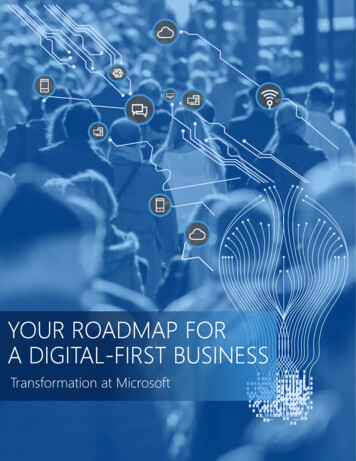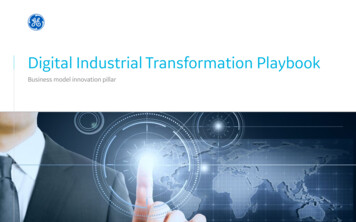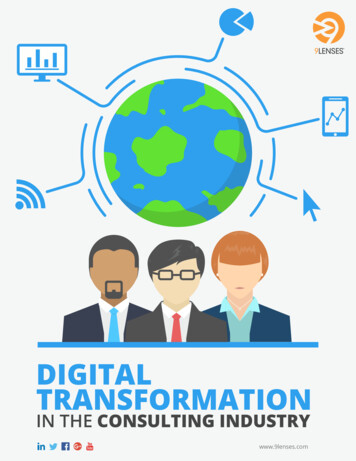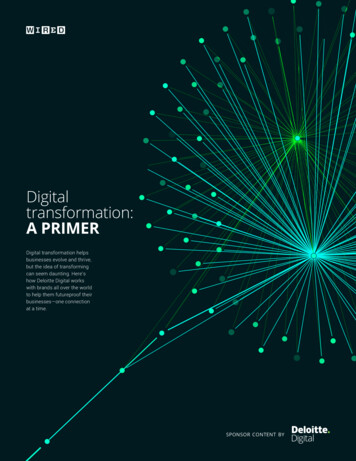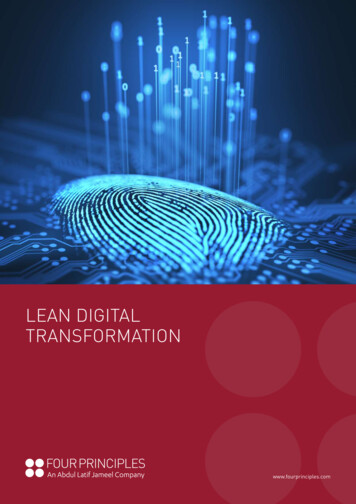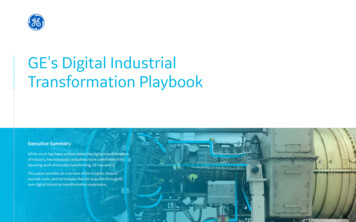
Transcription
GE's Digital IndustrialTransformation PlaybookExecutive SummaryWhile much has been written about the digital transformationof industry, few industrial companies have undertaken thedaunting work of actually transforming. GE has and is.This paper provides an overview of the insights, lessonslearned, tools, and techniques that GE acquired through itsown digital industrial transformation experience.
The Age of the Digital IndustrialThe industrial world has been shaped by a series offoundational technology changes over the last 250 years:steam and rail (1750-1830), electricity and telephone(1880-1920), computer and IT (1960-2000), and the currentera of Industrial Internet of Things (IIoT), and big data(2010-present).Each technology change introduced a wave of productivityimprovements accompanied by market disruption, wherebysome industrial leaders were displaced by the rise of agilenew competitors. Those incumbent leaders that invested innew capabilities often retained their market position.The current age of the digital industrial is marked by evermore powerful software and falling hardware costs. Thatis, today’s predictive algorithms and machine learningcapabilities enable use cases that were not possible evenfive years ago. And let’s not forget the steadily falling costof sensors, compute, storage, and bandwidth that hasmade the deployment of these capabilities a financialreality.The first Industrial IoT use cases focused on reducingunplanned downtime of key industrial assets such aspower generation machines and mining equipment.Industrial companies are now aggressively increasing thesurface area of instrumented assets beyond just expensivecritical machines. In other words, industrial firms areincreasing both the number of sensors on each asset as wellas the number of assets with sensors.
The result is not only the ability to develop a highresolution view of the future behavior of critical assets,but also the ability to develop a system view of anentire enterprise operation. This operational agility andpredictability is giving industrial companies the option topursue business model innovation by offering efficiency,productivity, and virtually everything “as a service.”Most recently, industrial companies have not matched thegrowth and valuation of the consumer Internet industry,with the latter enjoying much higher price-to-earningsmultiples.We believe this is about to change. Industrial companiesare entering a new period of explosive value creation. Therapid spread of digital innovation will reboot industrialproductivity growth.McKinsey estimates that the Industrial Internet of Thingswill create 7.5T in value by 2025. The Industrial Internetis non-optional—in the same category as electrification ofindustry in the last century. Those that move quickly willlikely enjoy lasting benefits. Those that move slowly well,their future is less certain.The Industrial Internet of Things will create 7.5T in value by 2025.
What Is a DigitalIndustrial?At its core, a digital industrialcompany uses data and analytics tocreate a "digital twin" of each of itskey processes and physical assets.This digital foundation enables thecompany to drive down costs whiledelivering consistent quality.It also enables the company to run a "digital thread" throughthe design, build, and service functions—using analyticintelligence to create a virtuous loop that delivers continuousimprovements to equipment for customers. This enablesindustrial companies to rapidly refactor operations, improveexisting offerings, bring new data-driven products to market,and innovate with new outcome-based business models.The foundational digital industrial components emergedin the 1990s: industrial control software (HMI/SCADA),manufacturing software (MES), and asset managementsoftware (APM). These technologies are common inindustrial environments. They deliver important capabilitiesthat are necessary, but not sufficient, for digital industrialtransformation. Up until the last 10 years, it was cost-prohibitive for many industrial companies to fully digitize andanalyze their operations. Full digital transformation—withcomprehensive digital twins and a complete digital thread—has been made possible by low-cost innovations.A "digital thread" enables industrialcompanies to rapidly refactor operations,improve existing offerings, bring new datadriven products to market, and innovate withnew outcome-based business models.GE's TransformationStoryIf we turn the clock back to the beginning of this decade,GE, like most companies, was very familiar with Moore’s lawand the falling cost of IT. But what caught many industrialcompanies by surprise was how these newly affordabletechnologies could be applied to an ever-growing set of usecases across the industrial world. With the cost to connectand leverage sensors continuing to drop, we could start to usethis data in ways we had only imagined years ago—gettinga richer, analytical view of assets, operations, demand, andsupply. We also observed aggressive new competitors thatattempted to disintermediate industrial hardware buyersfrom vendors like GE.As we embarked on broader and deeper instrumentationof assets, we created an enormous amount of data that wefed into our predictive algorithms and machine learningtechnologies. It was then that a holistic view of operationsbegan to emerge. It was also then that we started thinkingabout the Industrial Internet of Things as much more thana technology trend. We began to view it as a foundationaltechnology that could deliver material value creation andsustained competitive advantage.The result was that we moved from a defensive to anoffensive market position. That is, we pivoted from focusing ondefending our hardware service contracts to moving stronglyinto a growth orientation by investing in new capabilities andpursuing new business models.GE’s digital industrial strategy is straightforward. First, wefocus on leveraging our digital industrial capabilities to driveinternal productivity. This initiative, called “GE for GE,” is ontrack to impact more than 400 GE factories around the world.Next, we take the technologies, workflows, and productivitytechniques hardened through our internal deployments andmake them available to our customers. We call this “GE forCustomers.” In this category, we provide automation andpredictive capabilities in the form of packaged applications.Finally, we make our data and analytics operating system,Predix, available to everyone for co-creation. This initiative,called “GE for the World,” features an open-innovationapproach that is available to virtually any company in virtuallyany industrial category.
Digital IndustrialTransformationPlaybookOur Playbook boils down digitalindustrial transformation into five keypillar initiatives:Executing a digital industrial transformationstrategy can be daunting. As a nearly 130-yearold industrial firm, GE is not immune from thecomplexity required to implement meaningfulchange across culture, people, process,and technology.1Capabilities and operating model2Platform3Partner ecosystemWith several years of digital transformationexperience under our belt, we’ve been able toreverse-engineer a repeatable Digital IndustrialTransformation Playbook that can be used by ourcustomers and partners to embark on their owntransformation journeys.4Digital talent and culture5Business model innovation
1Capabilities and Operating ModelSuccessful transformations focus on capabilities thatwill differentiate the business and drive competitiveadvantage. The first step for any transformation is to re-thinkorganizational capabilities needed to start, scale, and sustainyour transformation. This requires developing an end-to-endview of the competencies, tools, processes, and governanceneeded across all functions—inclusive of sales, services,R&D, operations, and finance—as well as the accompanyingcomponent capabilities needed to succeed as a world-classdigital industrial. The end-to-end view also serves as a tool toidentify capability gaps, in addition to the plan for filling them.Next, industrial companies need to determine where and howthese capabilities are organized and executed within theirorganization (i.e., organization structure). A key considerationis the extent to which the company has vertical and horizontalbusiness lines. That is, do you have horizontal product linesor capabilities that span across multiple industry businessverticals? Do you have industry or product line specificcapabilities? The key is to find that elusive balance betweenaiming for horizontal scale and vertical specificity.At GE, we made a strategic choice to have our AssetPerformance Management and Field Service Managementas horizontal capabilities that could be leveraged across ourbusiness units. We created a new business unit, GE Digital, tonot only own these horizontal capabilities but also to act as adigital change agent within the company. Each GE business,such as GE Aviation, creates vertical extensions on top ofour horizontal capabilities. The result includes vertical digitalapplications such as GE Aviation’s Flight Efficiency solution.The connective tissue that makes this organizationalstructure work is the role of Chief Digital Officer (“CDO”). EachGE business has a CDO, who reports to both the business lineleadership (e.g., GE Aviation) and to GE Digital leadership. Thisdual-reporting structure ensures that GE Digital is buildingcapabilities that are relevant to its existing businesses andalso ensures that the existing businesses are fully leveragingGE Digital’s capabilities.The CDOs play a vital role in leading digital transformationin their business. They’re the digital role models leading thiscultural transformation, formulating the end-to-end businessstrategy, and articulating and delivering on the digital visionfor their business.
2PlatformMany of our customers and partners are contemplating a“build vs. buy” decision when it comes to an IIoT platform.Many of these firms are surprised to find how expensive itis—in terms of both time and financial resources—to establishthe foundational capabilities needed to even begin developingdigital industrial solutions.In other words, before you start building applications, youmust take on tasks such as setting up the infrastructure,integrating software stacks, deploying and collecting sensordata, managing data and meta data, staffing world-classsoftware and data science talent, building out industrial-gradeIT and OT security, and defining user models and access.GE built Predix because we needed an industrial-strength,edge-to-cloud platform that combined predictive analyticswith 3-D models of physical systems, featured a modulararchitecture of microservices, and that leveraged all of theagile development practices that allow industrials to keeppace with rapid technology innovation. We spent close to fouryears just getting the underlying plumbing and commercialback-end right. The result is a world-class digital industrialplatform that customers can scale up and down as marketdynamics change.With these foundational capabilities in place, customers areable to rapidly roll-out APM and field service solutions andaccelerate their digital transformation journey.
3Partner EcosystemWe quickly realized we couldn’t undertake true digitaltransformation on our own. The result is an open-innovationpartner ecosystem that spans industrial markets andindustrial outcomes.First, we had to change the way we worked with our partners.Like many industrials, GE traditionally had a robust resellerand distributor channel. With GE Digital, we opened theaperture of not only which types of entities could becomepartners but also what types of activities we would dowith partners.Our partner program now features a co-innovation model thatnot only includes resellers and distributors, but also includesleading technology partners, independent software vendors(ISVs), and thousands of developers. To onboard these newpartners, we vastly simplified our partner program acrossproducts, businesses, and geographies. Today, we have oneunifying partner program that features clear partnershiptiers for all partners. This single program serves the largestcompanies in the world right down to early-stage startups.Perhaps most importantly, our partner program features an“open-innovation” model, where partner solutions that arebuilt on Predix can be certified and made available to theglobal GE Digital user base.
4Digital Talent and CultureThis is arguably the most important of the digitaltransformation pillars. As Peter Drucker once said, “Cultureeats strategy for breakfast.” Digital industrial transformationrequires us to think and lead differently. The outside world ismoving fast, and a “leap of faith” is needed to keep up.At GE, we needed to rebuild the culture around rapid decisionmaking, learning from failure, and a new people managementprocess. We needed to compete for talent in the technologyspace; we had to look and feel like a fast-moving technologycompany. What you sell as the vision needs to feel real toemployees, and your culture must reflect an environment thatthrives on innovation.To that end, we rolled out what we call “GE Beliefs” as anaspiration. To become a digital industrial company, our leadersand employees are role-modeling these beliefs to make thema reality of our day to day: Customers determine our success Stay lean to go fast Learn and adapt to win Empower and inspire each other Deliver results in an uncertain worldNext, we developed a specific toolset and methodologyto help us iterate faster, to be more entrepreneurial, andto ensure we’re always building products and servicesthat deliver better outcomes for our customers. We callthis FastWorks, which combines the principles of LeanManufacturing with those of Agile Software Development. It’sat the heart of how we do what we do.Finally, we had to change the way we conducted performanceappraisals and talent management. We did away with theone-time annual performance management process andreplaced it with real-time feedback tools. PerformanceDevelopment, or PD as we call it, ensures that all employeesstay aligned with the GE Beliefs and are continuouslyleveraging FastWorks.While these tools have been instrumental in transformingthe GE culture, we didn’t have all the talent capabilities weneeded to be a digital industrial leader. This also required anenormous shift in how we recruit, develop, and incentivizetalent. Specifically, we needed more software DNA—bothfrom an engineering and commercial perspective. To makethat happen, we aligned our recruiting and compensationpractices to match those of leading software companies.The final step involved moving our corporate headquartersto the heart of downtown Boston, one of the world’s mostinnovative technology centers.
5Business Model InnovationBefore we innovated at the business model level, we drovedigital transformation of our internal operations, drivingmillions in productivity savings. This is where we encourageour customers to start considering their goals for growthand business model change. We believe that in the industrialworld, business model innovation relies on operations agilityas a foundation.By focusing on delivering tangible ROI today throughproductivity improvements, you can: Drive internal improvements that self-fund the next stepin your transformation journey such as new productintroductions, x-as-a-service model Build out the operational agility needed to innovate at thebusiness model level Enlist early internal champions and momentum needed todrive more radical transformationSuccess breeds success. Building credibility is the key toany successful transformation. With the data, insights,and improvements from these internal wins, you’re nowin a credible position to take those same productivityimprovements to your customers in the form of best practicesharing or even new products and services. Once you haveproven ability to deliver repeatable outcomes, you’re readyto experiment with new business models that leverage youroperational agility.
GE Digital TodayWe’ve used these principles totransform GE into a world-classdigital industrial company. Today,we have over 19,000 GE employeesfocused on digital transformationacross the company. Our customersand partners are leveraging ourDigital Industrial TransformationPlaybook to improve theircompetitiveness and to unlockbillions of dollars of value. Theresult is that GE is on track tobecoming one of the world’sleading data and analyticscompanies.
Getting Started onYour Digital IndustrialTransformationWhat does successful digital industrialtransformation look like?To help drive our customers’ digital transformation journeys, wehave set up Global Foundries across various locations, includingShanghai, Paris, and San Ramon. In these state-of-the-art co-creationcenters, we bring together our designers, data scientists, softwareengineers, and domain experts to co-create our customers’ digitaltransformation steps customized to their maturity and aspirations.You can work side-by-side with a GE Digital Foundry and domainexpert to create a strategic business case for digital transformation,develop proof-of-concept/value, learn more about Predix, and developa roadmap for your digital industrial transformation. Learn more aboutour Global Foundries to start your digital industrial journey!Learn more about Pitney Bowes' digital transformation.GE is on track to becoming one of the world's leadingdata and analytics companies.We transformed GE into a digital industrial company. We continue toreimagine and refine the capabilities, culture, and talent needed tooptimize GE, our customers, our partners, and the Industrial Internetfor the world. With our Digital Industrial Transformation Playbook, wecan now accelerate the transformation of other like-mindedindustrial companies.Why not your company? Why not now?For our customer, Pitney Bowes, it means helping 1.5 million clients in approximately 100countries generate real-time insights and drive higher levels of operational performance. Withsolutions powered by Predix—the operating system for the Industrial Internet—Pitney Bowes isdriving equipment and operational productivity with real-time analytics enabled by connectedindustrial sensors, machine data, people, and processes.Taking the Industrial Internet to thenext levelSchindler, a 142-year-old leader in elevators, escalators, and moving walkways, tracks andmonitors its assets with Predix, the operating system for the Industrial Internet. Predix allowsSchindler to track its products to identify service issues and, through analytics, start predictingmaintenance issues long before equipment fails. It will help the company realize savings byreducing unplanned downtime and maintenance costs—an example of the power of digitalindustrial transformation at work.Learn more about Schindler's path toward transformation.
AuthorsAkanksha Manik TalyaMatt MattoxAkanksha Manik Talya is the Director of GE Digital's Global Foundry Strategyand Operations. Ms. Talya has a background in management consultingexperience, advising technology companies on driving digital, operatingmodel, culture, and organizational transformations. She joined GE in 2016 tolead the global development of GE's Global Foundries. Ms. Talya has an MBAfrom Darden Graduate School of Business at the University of Virginia and anundergraduate degree in electrical engineering from India.Matt Mattox is the Vice President of Industry Solutions at GE Digital. He hasa background in building enterprise software companies from concept toscale. Most recently, Mr. Mattox co-founded an IoT healthcare technology firmbacked by the Mayo Clinic and Canaan Partners. Previously, he held leadershippositions at Red Hat, MIT Technology Review, and idealab!. Mr. Mattox hasdegrees from Clemson University and Harvard University.About GEGE (NYSE: GE) is the world’s Digital Industrial Company, transforming industry with software-defined machinesand solutions that are connected, responsive and predictive. GE is organized around a global exchange ofknowledge, the “GE Store,” through which each business shares and accesses the same technology, markets,structure and intellect. Each invention further fuels innovation and application across our industrial sectors.With people, services, technology and scale, GE delivers better outcomes for customers by speaking thelanguage of industry.Contact InformationAmericas: 1-855-YOUR1GE (1-855-968-7143)gedigital@ge.comwww.ge.com/digital 2017 General Electric. All rights reserved. *Trademark of General Electric. All other brands or names are property of their respective holders.Specifications are subject to change without notice. 08 2017
Digital Industrial Transformation Playbook Executing a digital industrial transformation strategy can be daunting. As a nearly 130-year-old industrial firm, GE is not immune from the complexity required to implement meaningful change across culture, people, process, and technology. With



